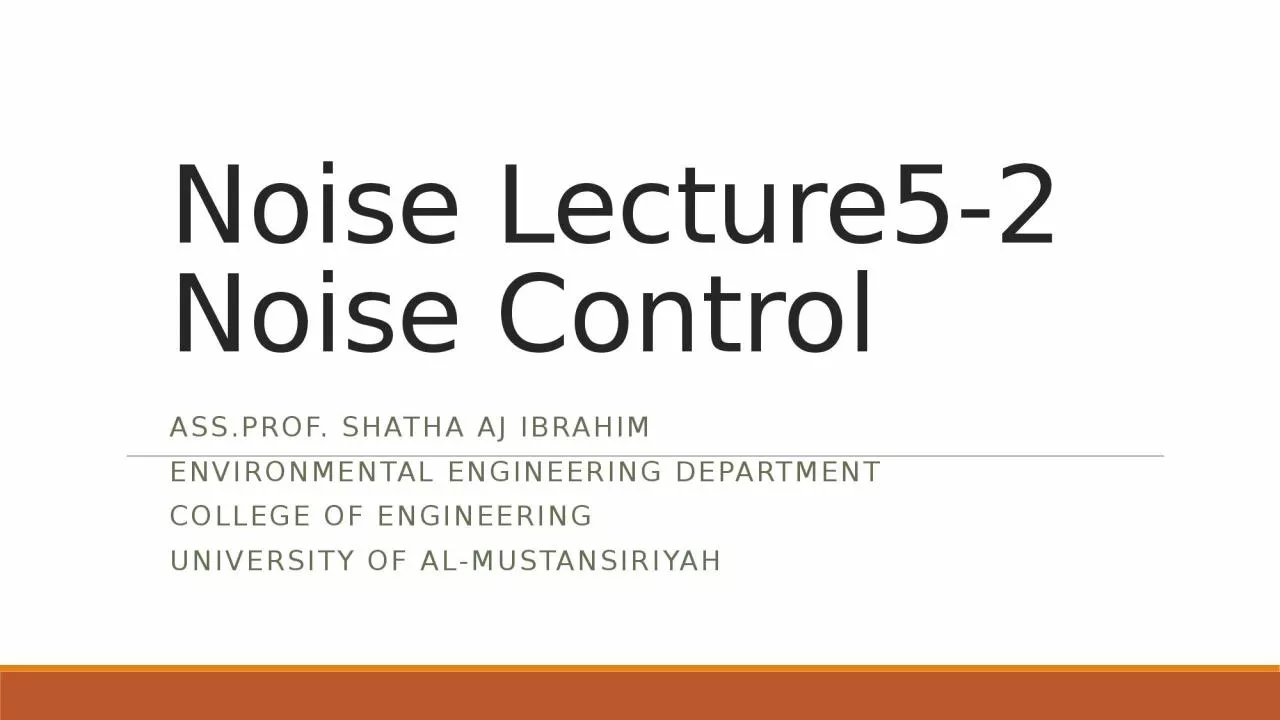

AssProf Shatha AJ Ibrahim Environmental Engineering Department College of Engineering University of Al Mustansiriyah 6Provide mufflers silencer the devices can be classified into 2 fundamental groups Absorptive muffler is one whose noise reduction is determined mainly by th ID: 1029646
Download Presentation The PPT/PDF document "Noise Lecture5-2 Noise Control" is the property of its rightful owner. Permission is granted to download and print the materials on this web site for personal, non-commercial use only, and to display it on your personal computer provided you do not modify the materials and that you retain all copyright notices contained in the materials. By downloading content from our website, you accept the terms of this agreement.
1. Noise Lecture5-2Noise ControlAss.Prof. Shatha AJ IbrahimEnvironmental Engineering DepartmentCollege of EngineeringUniversity of Al-Mustansiriyah
2. 6-Provide mufflers (silencer): the devices can be classified into 2 fundamental groups: Absorptive muffler (is one whose noise reduction is determined mainly by the presence of fibrous or porous materials, which absorb the sound). The attenuation produced, in dB per meter run of duct, depends on α, the sound absorption coefficient of the lining material and the ratio of perimeter to cross sectional area of the duct (P/S).
3.
4. Reactive muffler: a) the expansion principle. b) simple expansion chamber c) multiple expansion chamber with tail and interconnecting pipes; dimensions relevant to silencer performance are indicated d)resonant silencers e) plenum chamber
5. 5.3 Noise Control in the Transmission Path After individual have tried all possible ways of controlling the noise at the source, the next line of defense is to set up devices in the transmission path to block or reduce the flow of sound energy before it reaches the ears. This can be done in several ways: a) absorb the sound along the path. b) deflect the sound in some other direction by placing a reflecting barrier in its path. c) contain the sound by placing the source inside a sound insulating box or enclosure. Selection of the most effective technique will depend upon various factors, such as the size and type of source, intensity and frequency range of the noise, and the nature and type of environment. 1-Separation: air absorbs high frequency sounds more effectively than it absorbs low frequency sounds. However, if enough distance is available, even low frequency sounds will be absorbed appreciably, if you can double your distance from appoint source, you will have succeeded in lowering the SPL by 6 dB. Indoors, the noise level generally drops only from 3 to 5 dB foe each doubling of distance in the near vicinity of the source. However, further from the source, reductions of only 1 or 2 dB occur for each doubling of distance due to the reflections of sound off hard walls and ceiling surfaces.
6.
7. Third, in the shadow zone, the noise is transmitted directly through the barrier may be significant in some cases. For example, with extremely large angles of diffraction, the diffracted noise may be less than the transmitted noise. In this case, the transmitted noise compromises the performance of the barrier. It can be reduced by constructing a heavier barrier. The allowable amount of transmitted noise depends on the total barrier attenuation desired. The fourth path is the reflected path. After reflection, the noise is of concern only to a receiver on the opposite side of the source. For this reason, acoustical absorption on the face of the barrier may sometimes be considered to reduce reflected noise; however, this treatment will not benefit any receivers in the shadow zone. It should be noted that in most practical cases the reflected noise does not play an important role in barrier design. The required barrier length depends on the total net attenuation desired.
8.
9. 5.4 Noise Control at the Receiver When exposure to intense noise fields is required and none of the measures discussed so far is practical, there are of possibilities, depending upon whether the problem is one of occupational or environmental noise exposure. These include:1) Control of exposure time, i.e. time working on noisy processes.2) Job rotation3) Provision of personal hearing protection (earmuffs, earplugs, and helmets), such devices may provide noise reductions ranging from 15 to 35 dB (A).4) Provision of quiet working areas for time when not working on the noisiest processes.5) Regular audiometric monitoring of the hearing levels of personnel.6) Relocation.